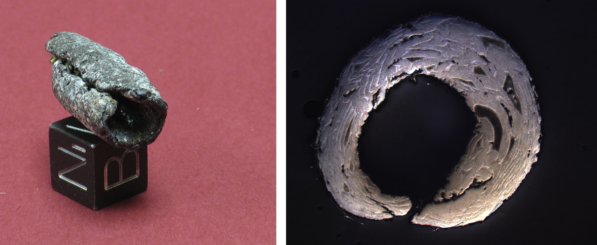Scientists discover origins of ancient Hopewell culture's meteorite jewellery
The beads were discovered in a burial mound in Illinois in 1945 but until now where they came from had been a mystery.
The native Hopewell culture, which thrived along rivers and streams in North America from 200BC to 500AD, is today survived by a number of beautiful artefacts made from exotic materials – including copper and silver.
But perhaps the most exotic Hopewell artefacts are those made from iron extracted from meteorites. It is not known how these artefacts were viewed among the Hopewell, but what is certain is that they were extremely scarce due to the fact that meteoritic iron is so rare.
In 1945, researchers discovered 22 beads made of meteoritic iron, hidden in a burial mound at the Havana site in Illinois. A number of studies over the following decades attempted to describe these mysterious beads, analyse their chemical composition and understand their significance for the Hopewell people.
However, questions remained about the origins of the meteoritic iron used to create these beads – and how the people who manufactured them acquired this rare material. One of the main obstacles confronting scientists trying to understand the importance of meteorites in Hopewell culture is the absence of a confirmed link between Hopewell meteoritic artefacts and known meteorites.
In a study published in the journal of Archaeological Science, a team led by Timothy McCoy from the National Museum of Natural History decided to investigate the issue further and find out if they could link the beads to a specific meteorite found in North America.
McCoy told IBTimes UK: "Meteorites have a long history of use by humans, reaching back at least 5,000 years including to make knives, hammer stones, beads, adzes (axes), and, among more recent objects, a camel charm. This kind of study helps to learn about relationships between ancient objects, but it really provides a window into how meteorites have been collected and used in the past."

A link with Anoka iron
The study established a link between the iron used to created the Havana beads and iron from a meteorite in Anoka, Minnesota.
The scientists in fact decided to do this study when new masses of Anoka iron were recovered recently. This suggested that a shower of iron had occurred at some point in the past near the Mississippi River – and thus would have been accessible to the Hopewell community living in Havana.
The team analysed three of the meteoritic iron beads and samples and a polished section of Anoka iron from a sample excavated in 1983. Using a special microscope they studied the metallic composition of the samples and determined their chemical composition. These analyses led them to identify a similarity in major, minor and trace element chemistry between Anoka iron and the Havana beads. Thus, it is likely that the beads were produced in Havana from a mass of the Anoka iron.
These findings are significant because they shed a new light on the social and economic organisation of the Hopewell culture. Two different models of trade have been proposed by historians and continue to compete to this day.
The first is that of a regularised system of trade with neighbouring communities exchanging material and ideas, known as the Hopewell Interaction Sphere – commonly referred to as HIS. The second was established years after HIS gained widespread usage and proposes that people made individual trips to sites of resources and then returned to their lands – the Hopewell Expeditionary Resource theory.
"Meteorites are exceptionally rare objects. While it might make sense for an individual to travel to the site of large copper deposits and bring back material, it is difficult to reconcile that kind of model with something like a meteorite. By establishing a link between Anoka, Minnesota and Havana, Illinois – two places within reach of known Hopewell centres and connected by major river systems – the trade model seems much more plausible", McCoy concluded.
© Copyright IBTimes 2025. All rights reserved.






















